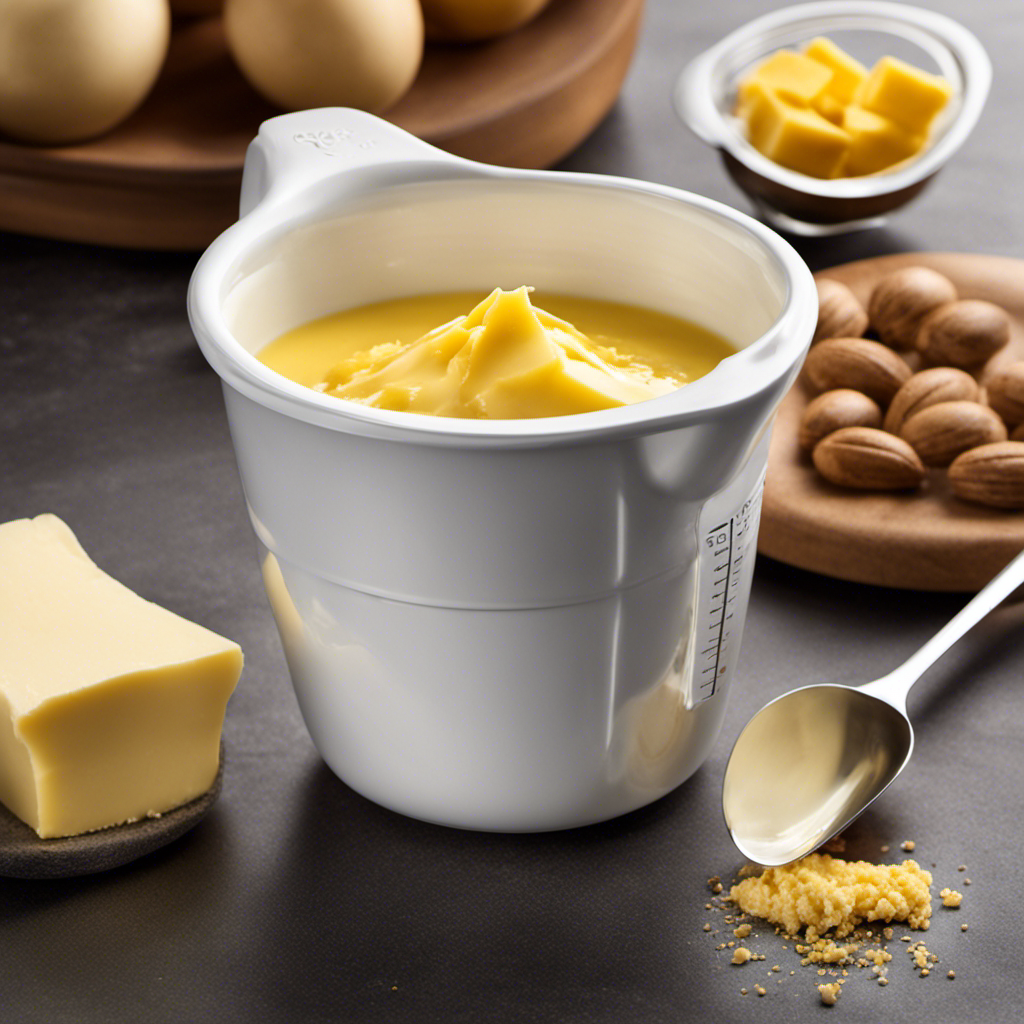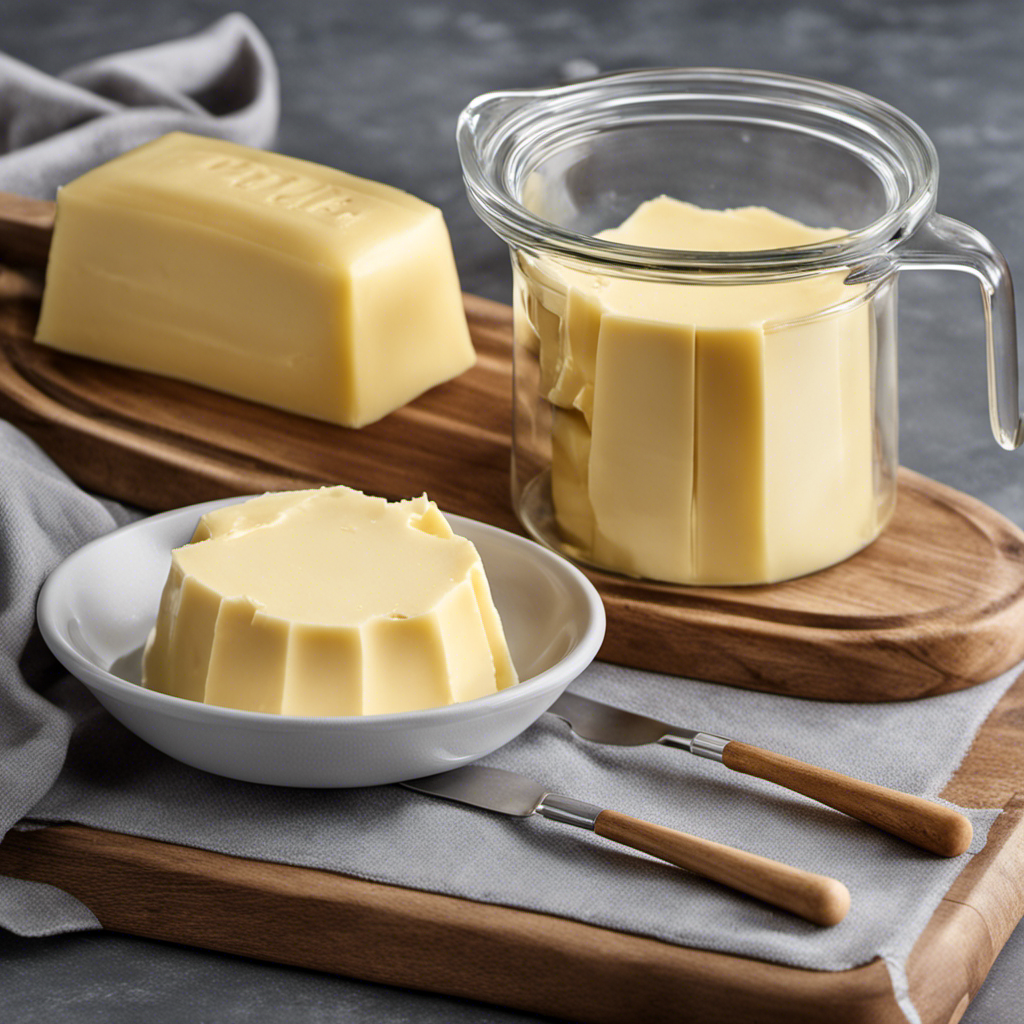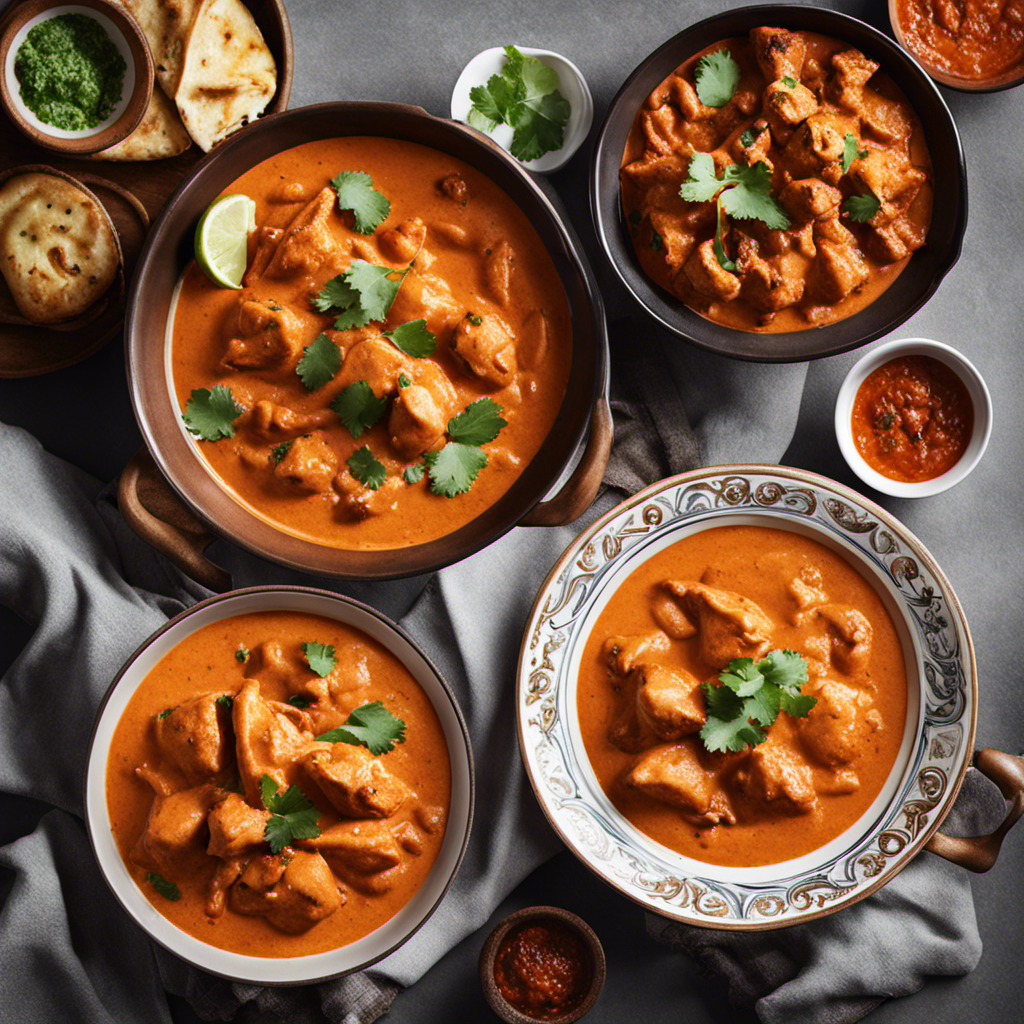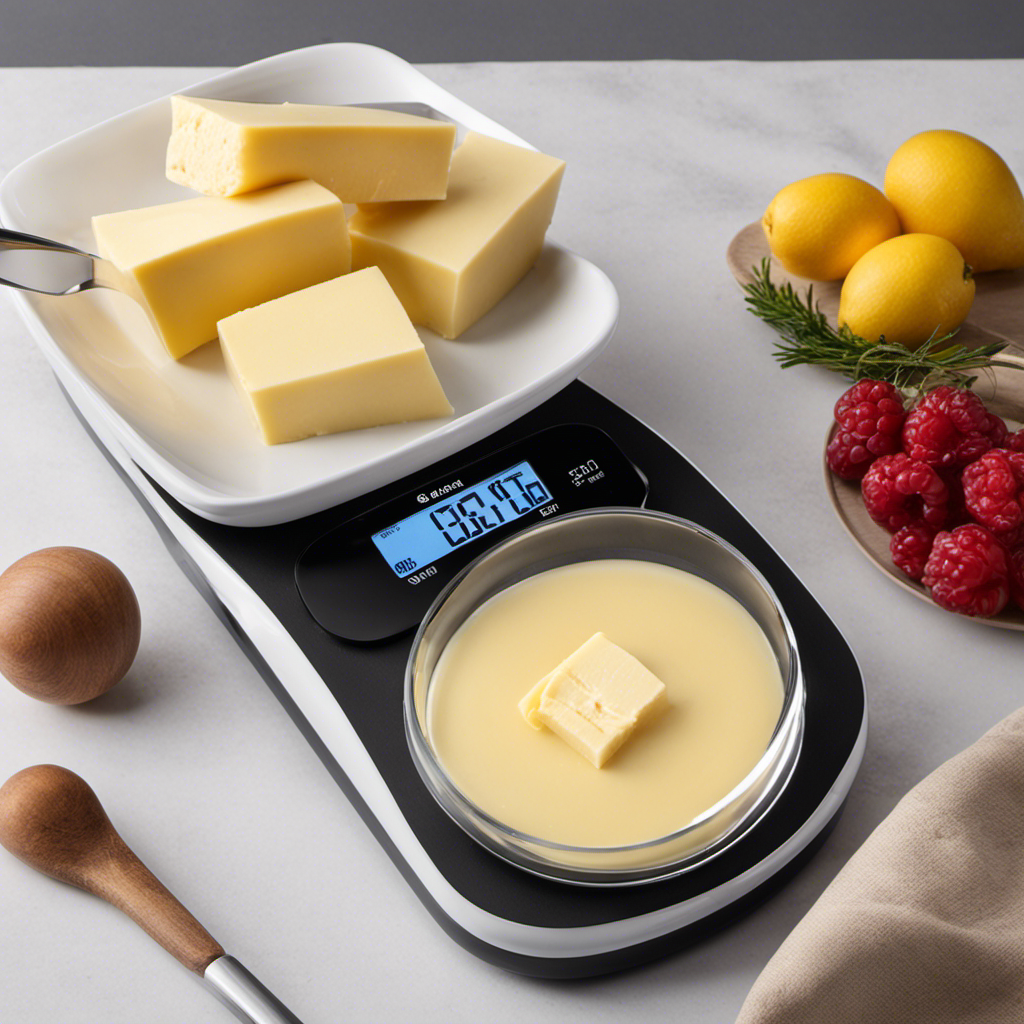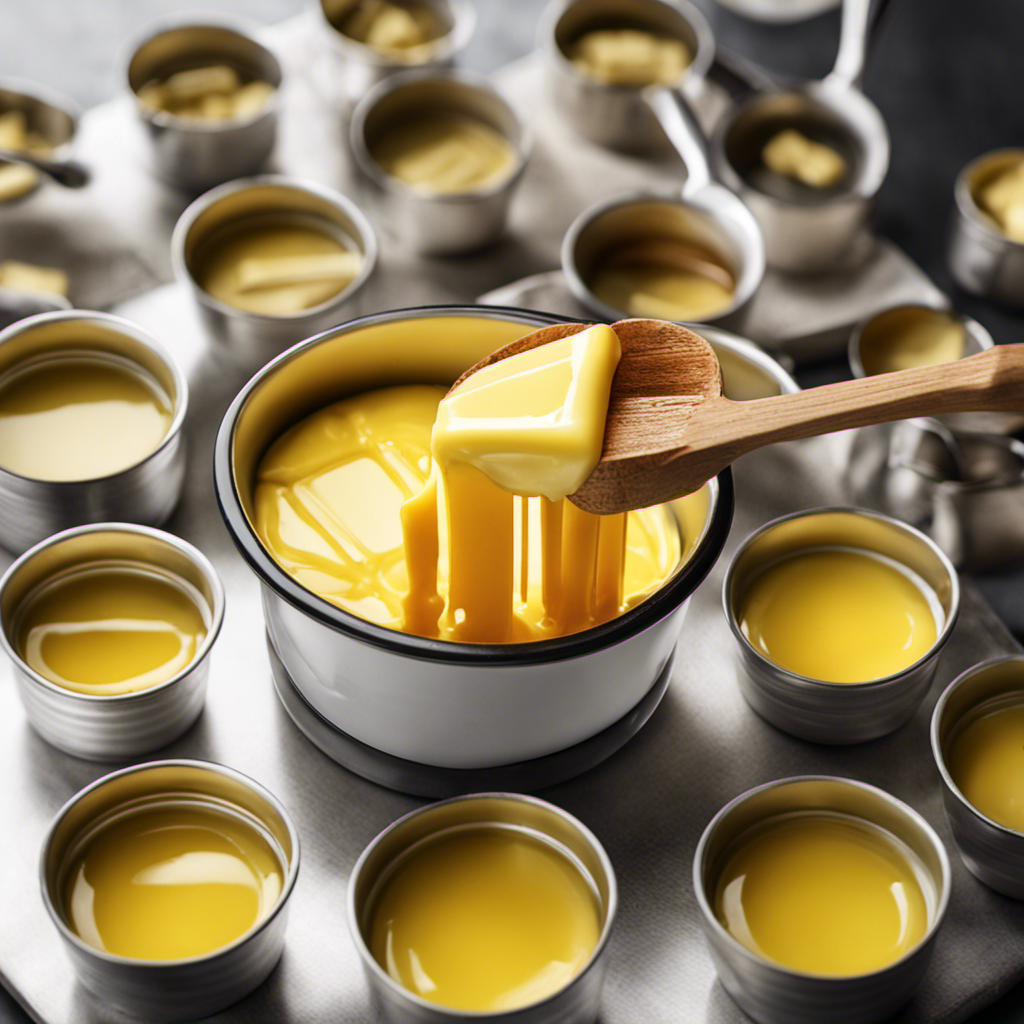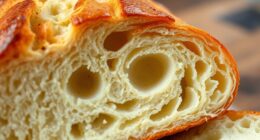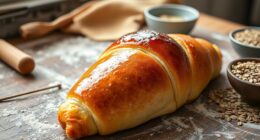As someone who cooks at home, I regularly find myself in the kitchen, pondering over the exact quantities of ingredients required. A common question that pops up is, ‘What is the equivalent of 2/3 cup of butter in tablespoons?’ Knowing this conversion is essential for the correct preparation of recipes.
In this article, I’ll delve into the basics of butter measurements and provide you with the necessary knowledge to adjust recipes that call for 2/3 cup of butter.
So, let’s dive in and explore the world of butter conversions together!
Key Takeaways
- Accurate measurements are crucial for achieving desired results in recipes.
- The conversion ratio for butter is 1 cup equals 16 tablespoons.
- Different types of butter may have different densities, affecting the conversion ratio.
- Use a measuring cup designed for liquids or solids, depending on the state of the butter, for precise measurements.
Understanding the Conversion Ratio
To understand the conversion ratio, you’ll need to know that 1 cup of butter is equivalent to 16 tablespoons. This knowledge is crucial for measuring accuracy when dealing with butter substitutes.
When a recipe calls for a specific amount of butter, it’s important to be precise in your measurements to ensure the desired outcome of the dish. Using the correct conversion ratio is key to achieving the same results as using real butter.
Measuring accuracy becomes even more important when substituting butter with alternatives like margarine or oil. These substitutes have different consistencies and moisture levels, which can affect the final texture and taste of the dish.
The Importance of Accurate Measurements
Make sure you accurately measure ingredients to ensure your recipes turn out as intended. Measuring accuracy is crucial when it comes to cooking and baking.
Here are a few reasons why precise measurements are important:
-
Consistency: Accurate measurements ensure that your recipes are consistent each time you make them. This is especially important if you are following a specific recipe for a competition or a special event.
-
Taste: Using the correct amount of ingredients ensures that your dish tastes just right. Too much or too little of an ingredient can affect the flavor and overall outcome of your recipe.
-
Texture: Precise measurements can also affect the texture of your dish. Whether it’s a cake that needs to be light and fluffy or a sauce that needs to be thick and creamy, accurate measurements play a significant role.
When it comes to butter substitutes, measuring accuracy becomes even more crucial. Different butter substitutes have different water content and fat ratios, so it’s important to measure them accurately to achieve the desired result in your recipe.
Converting Cups to Tablespoons
Remember, when converting measurements from cups to tablespoons, it’s important to use the correct ratio to ensure accurate results in your recipe. Understanding conversions can be tricky, but with the right information, you can avoid common measurement mistakes. To help you with this, I have created a table below that shows the conversion ratio for cups to tablespoons:
| Cups | Tablespoons |
|---|---|
| 1 | 16 |
| 1/2 | 8 |
| 1/3 | 5 1/3 |
| 1/4 | 4 |
The Basics of Butter Measurements
Understanding the basics of measuring butter correctly is essential for achieving accurate results in your recipes. When it comes to measuring accuracy, there are a few key points to keep in mind:
- Use a proper measuring cup designed for dry ingredients, rather than a liquid measuring cup, to ensure accuracy.
- Softened butter should be packed into the measuring cup firmly, with no gaps or air pockets.
- For solid butter, use a knife or spoon to level off the excess butter from the top of the measuring cup.
In addition to measuring accuracy, it’s also important to consider butter substitutes. While butter adds richness and flavor to recipes, there are alternatives available for those who are lactose intolerant or following a vegan diet. Some popular butter substitutes include margarine, coconut oil, and vegetable shortening. However, keep in mind that these substitutes may alter the taste and texture of your dishes, so experimentation and adjustment may be necessary.
How Many Tablespoons in a Cup
When it comes to cooking and baking, accurate measurements are crucial for achieving the desired outcome. Understanding conversion ratios for cups, tablespoons in a cup, and butter measurement conversions is essential for any aspiring chef or home cook.
In this discussion, I will delve into the intricacies of these conversions, providing you with precise information to ensure your recipes turn out perfectly every time.
Conversion Ratios for Cups
To convert cups to tablespoons, you can use a simple conversion ratio. Understanding butter conversions is important for accurate measurements. Here are some tips to help you get it right:
- Use the conversion ratio of 16 tablespoons per cup.
- Divide the number of cups by 1/16 to get the equivalent in tablespoons.
- For example, if you have 2/3 cup of butter, divide 2/3 by 1/16. This equals 10 and 2/3 tablespoons.
When measuring butter, make sure it is at room temperature for accurate results. Use a measuring cup specifically designed for liquids to measure butter. Pack the butter firmly into the cup to ensure an accurate measurement.
Tablespoons in a Cup
Now that we have covered conversion ratios for cups, let’s dive into the topic of tablespoons in a cup. Understanding conversion accuracy is essential when measuring butter alternatives.
In cooking, a cup is equal to 16 tablespoons. This measurement is consistent across most recipes and culinary references. However, it is crucial to note that different ingredients may have varying densities, which can affect the accuracy of measurements.
When measuring butter alternatives, such as margarine or oil, it is essential to consider their specific conversion ratios. For example, if a recipe calls for 2/3 cup of butter, you would need to measure out 10 and 2/3 tablespoons of the butter alternative to ensure accurate results.
Butter Measurement Conversions
Understanding the accurate conversion ratios for butter alternatives is crucial in cooking. When it comes to butter, it is important to know the density and convert it accurately from ounces to tablespoons. Here are some key points to consider:
-
Butter density: Different types of butter have different densities, which can affect the conversion ratio. For example, European butter is denser than American butter, so the conversion ratio may vary.
-
Converting butter from ounces to tablespoons: The general rule is that 1 ounce of butter is equal to 2 tablespoons. However, this can vary depending on the density of the butter. It is always recommended to check the specific conversion ratio for the type of butter you are using.
-
Precision in measurements: When converting butter from ounces to tablespoons, it is important to be precise in your measurements. Using a kitchen scale to weigh the butter can ensure accurate conversions and consistent results in your recipes.
The Conversion Formula
The conversion formula for determining how many tablespoons are in 2/3 cup of butter is straightforward and essential for understanding conversion formulas and the importance of precise measurements.
In order to calculate the number of tablespoons in 2/3 cup of butter, you need to know that there are 16 tablespoons in 1 cup. Therefore, you can multiply 2/3 by 16 to find the answer. Simplifying the fraction, you get 10 2/3 tablespoons. This means that there are 10 tablespoons plus 2/3 of a tablespoon in 2/3 cup of butter.
It is crucial to be precise in your measurements when following recipes to ensure accurate results. Now that we know the conversion formula, let’s move on to calculating 2/3 cup of butter.
Calculating 2/3 Cup of Butter
When it comes to converting measurements for butter, accuracy is crucial. In this discussion, I will delve into the conversion process for 2/3 cup of butter and the importance of measuring it accurately.
We will explore the necessary steps and techniques to ensure precise measurements and avoid any discrepancies in your recipes.
Conversion for Butter
To convert 2/3 cup of butter into tablespoons, you’ll need to multiply it by 16. This conversion is necessary when working with recipes that require precise measurements.
Understanding butter ratios and following accurate butter measurements is essential for achieving desired results in baking and cooking. Here are some tips to ensure accurate butter measurements:
- Always use a measuring cup specifically designed for liquids or solids, depending on the state of the butter.
- Softened butter should be packed into the measuring cup, ensuring there are no air gaps.
- If a recipe calls for melted butter, measure it in its liquid form using a liquid measuring cup.
- Remember to level off the top of the butter with a straight edge for precise measurements.
Following these tips will help you maintain consistency and accuracy in your recipes, ensuring delicious and well-balanced flavors.
Measuring Accuracy for Butter
Make sure you accurately measure your butter by using a scale for precise results. When it comes to baking, precision is key, and even a small error in butter measurement can affect the final outcome of your baked goods.
Common mistakes in butter measurements include using the wrong measuring tool, such as a liquid measuring cup instead of a dry measuring cup, or eyeballing the amount instead of using a scale. To ensure accuracy, I recommend using a digital kitchen scale that can measure in grams or ounces. This will give you the most precise measurement for your butter.
By following this method, you can avoid any inconsistencies in your recipes and achieve the perfect results every time.
Now, let’s delve into the role of butter in baking and how it contributes to the texture and flavor of your baked goods.
The Role of Butter in Baking
You’ll be surprised by how butter plays a crucial role in baking. It not only adds flavor but also contributes to the texture and structure of baked goods. Here are some important points to consider about butter in baking:
-
Butter substitution:
-
Margarine can be substituted for butter in most baking recipes, but it may affect the taste and texture of the final product.
-
Coconut oil can be used as a dairy-free alternative to butter, but it has a distinct flavor that may not work well in all recipes.
-
Applesauce or mashed bananas can be used as a healthier substitute for butter in some recipes, but it may result in a denser texture.
-
Butter storage:
-
Butter should be stored in an airtight container in the refrigerator to maintain its freshness.
-
It is best to use butter within a month of purchase, as it can become rancid over time.
-
If you need softened butter for a recipe, leave it at room temperature for about 30 minutes or use a microwave on low power.
Tips for Measuring Butter
Now that we understand the importance of butter in baking, let’s explore some tips for measuring butter accurately.
When it comes to measuring butter, the most common method is using tablespoons. One stick of butter is equal to 8 tablespoons or 1/2 cup. However, if your recipe calls for a different amount, it’s helpful to know some alternative measuring techniques.
For instance, if you need 2/3 cup of butter, you can measure out 10 and 2/3 tablespoons, as each tablespoon is equivalent to 1/16 cup. Another option is to use a kitchen scale to measure the weight of the butter. This can be particularly useful when you need precise measurements.
In the next section, we will discuss alternative methods for measuring butter that can come in handy in different situations.
Alternative Methods for Measuring Butter
When it comes to accurately measuring ingredients for baking or cooking, there are several alternative methods that can be used.
One option is to use a digital kitchen scale, which provides precise measurements in grams or ounces.
Another option is to use butter measuring molds, which are specifically designed to measure and dispense butter in tablespoons or grams.
Lastly, standard measuring cups can also be used to measure butter, although it may require some conversion calculations depending on the recipe.
Digital Kitchen Scale
To accurately measure the weight of ingredients like butter, try using a digital kitchen scale. With a digital scale, you can achieve precise measurements for your recipes.
Here are some benefits of using a digital scale:
-
Accuracy: A digital scale provides accurate weight measurements, ensuring that you add the right amount of ingredients to your recipe.
-
Convenience: Digital scales are easy to use and often come with a tare function, allowing you to zero out the weight of the container and measure only the ingredients.
-
Versatility: Digital scales can weigh ingredients in various units, such as grams, ounces, pounds, and kilograms, making it suitable for a wide range of recipes.
Weighing ingredients with a digital scale eliminates the guesswork and helps you achieve consistent results in your cooking and baking endeavors.
Butter Measuring Molds
Using butter measuring molds can be a convenient way to ensure consistent and accurate measurements for your recipes. Butter molds are specialized butter measurement tools that are designed to hold a specific amount of butter, typically in tablespoons or grams. These molds are made from durable materials such as silicone or stainless steel, ensuring their longevity and ease of use.
To measure butter using a butter mold, simply press softened butter into the mold until it is filled to the desired measurement. The compact and defined shape of the butter in the mold allows for easy and precise measurements, making it a reliable tool for bakers and cooks.
However, if you don’t have a butter mold, you can also use standard measuring cups, which I will discuss in the next section.
Using Standard Measuring Cups
If you’re looking for a simple and versatile way to measure ingredients, standard measuring cups are a must-have tool in your kitchen. When it comes to measuring butter for cooking, understanding its consistency is key.
Here are a few things to keep in mind:
-
Softened butter: This refers to butter that has been left at room temperature until it is easily spreadable. It should still hold its shape but be soft enough to easily mix into other ingredients.
-
Melted butter: This is butter that has been heated until it is completely liquid. It is often used in recipes where a liquid fat is required.
-
Cold butter: This is butter that has been chilled in the refrigerator. It is usually used in recipes where the butter needs to be cut into small pieces or where a flaky texture is desired.
By using standard measuring cups, you can accurately measure these different types of butter for your recipes.
Now, let’s move on to converting butter measurements in recipes.
Converting Butter Measurements in Recipes
You can easily convert butter measurements in recipes by knowing that 2/3 cup of butter is equal to 10 and 2/3 tablespoons. Understanding butter equivalents is essential for accurate measurements in cooking and baking.
When converting butter measurements to grams, it’s important to know that 1 tablespoon of butter weighs approximately 14 grams. So, 10 and 2/3 tablespoons of butter would be approximately 149 grams. This conversion can be helpful when following recipes that use grams as the unit of measurement.
Adjusting recipes with 2/3 cup of butter becomes easier once you have converted the measurement to tablespoons or grams. By understanding the equivalent measurements, you can confidently modify recipes to suit your needs.
Adjusting Recipes With 2/3 Cup of Butter
To adjust recipes with 2/3 cup of butter, it’s helpful to know the equivalent measurements in tablespoons or grams. This will ensure accurate and precise proportioning of ingredients.
When substituting butter in recipes, consider the following:
-
Converting to tablespoons:
-
2/3 cup of butter is approximately 10 tablespoons.
-
Each tablespoon contains about 14.18 grams of butter.
-
Therefore, 2/3 cup of butter is equivalent to approximately 141.8 grams.
-
Adjusting ingredient proportions:
-
If you want to reduce the amount of butter, divide the recipe’s butter measurement by 3, and then multiply by 2 to get the adjusted amount.
-
If you want to increase the amount of butter, divide the recipe’s butter measurement by 2, and then multiply by 3 to get the adjusted amount.
Butter Substitutes and Equivalents
When it comes to finding alternatives to butter, vegan options have become increasingly popular.
In this discussion, I will explore various vegan butter alternatives that can be used in cooking and baking.
Additionally, I will provide information on converting measurements from butter to these vegan alternatives, ensuring accurate and successful recipe outcomes.
Vegan Butter Alternatives
There’s a wide variety of vegan butter alternatives available on the market. As someone who follows a vegan lifestyle, I have explored these options extensively. Here are some key points to consider when it comes to vegan butter substitutes:
-
Texture and taste: Vegan butter substitutes are designed to mimic the texture and taste of traditional butter. They can be creamy, spreadable, and have a rich flavor that closely resembles dairy butter.
-
Health benefits: Unlike dairy butter, vegan butter substitutes are cholesterol-free and lower in saturated fats. They are often made from plant-based oils and contain essential fatty acids, which can be beneficial for heart health.
-
Versatility: Vegan butter substitutes can be used in various culinary applications, including baking, cooking, and spreading on toast. They can be substituted in equal amounts for butter in recipes.
-
Availability: With the increasing popularity of plant-based diets, vegan butter alternatives are widely available in grocery stores and online.
Overall, vegan butter substitutes offer a great option for those looking to enjoy the benefits of butter without the use of animal products.
Converting Butter Measurements
Converting butter measurements can be tricky, but using a kitchen scale makes it easier.
Understanding butter measurements is crucial for accurate baking and cooking. To measure butter accurately, it is important to know the conversion factors.
One stick of butter is equal to 8 tablespoons or 1/2 cup. So, if a recipe calls for 2/3 cup of butter, you will need approximately 10 and 2/3 tablespoons.
To measure butter without a scale, you can use the markings on the butter wrapper. Each tablespoon is usually marked on the wrapper, making it easier to measure.
Another helpful tip is to soften the butter before measuring, as cold butter can be difficult to measure accurately.
Converting Other Butter Measurements
If you’re wondering about other butter measurements, you can use online converters to easily find the equivalent amounts. These converters are a great tool for quickly and accurately converting butter measurements to different units.
Here are some alternative measuring methods and butter measurement equivalents that you can find using these converters:
- Cups to Grams: Convert cups of butter to grams for precise measurements.
- Sticks to Tablespoons: Determine how many tablespoons are in a stick of butter.
- Ounces to Cups: Convert ounces of butter to cups for recipes that require larger quantities.
Using these alternative measuring methods and butter measurement equivalents, you can ensure that your recipes come out perfectly every time. Online converters make it easy to find the exact measurements you need, saving you time and effort in the kitchen.
Frequently Asked Questions
Can I Use Margarine Instead of Butter in This Recipe?
Yes, you can use margarine instead of butter in this recipe. Margarine is a vegan butter substitute that can provide a similar texture and flavor. However, it’s important to consider the pros and cons of using margarine, such as its lower nutritional value and potential artificial additives.
How Do I Measure Butter if I Don’t Have a Tablespoon?
To measure butter without a tablespoon, you can use a kitchen scale or the markings on the butter wrapper. Alternatively, you can estimate using a knife or a butter dish with measurements.
Are There Any Vegan Substitutes for Butter in Baking?
As a vegan baker, I’ve discovered amazing alternatives to butter. Vegan butter substitutes, like coconut oil or avocado, not only provide a plant-based option but also offer health benefits and unique flavors to enhance your baked goods.
How Can I Convert Grams or Ounces of Butter to Tablespoons?
To convert grams or ounces of butter to tablespoons, you need to know the conversion ratio. There are measuring alternatives available, such as using a kitchen scale or referring to conversion charts for accurate measurements.
Can I Substitute Oil for Butter in This Recipe and if So, What Is the Conversion Ratio?
I can substitute oil for butter in this recipe. The conversion ratio is 1:1, meaning you would use the same amount of oil as the amount of butter called for in the recipe.
Conclusion
In conclusion, understanding the conversion ratio between cups and tablespoons is crucial for accurate measurements in recipes.
Converting 2/3 cup of butter to tablespoons requires knowing that there are 16 tablespoons in a cup.
By adjusting recipes with this measurement, one can ensure the perfect balance of ingredients.
Additionally, it’s important to be aware of butter substitutes and their equivalents.
By mastering these butter measurements, you’ll be well-equipped to create culinary masterpieces with precision and finesse, just like a skilled conductor leading an orchestra to create harmonious melodies.

